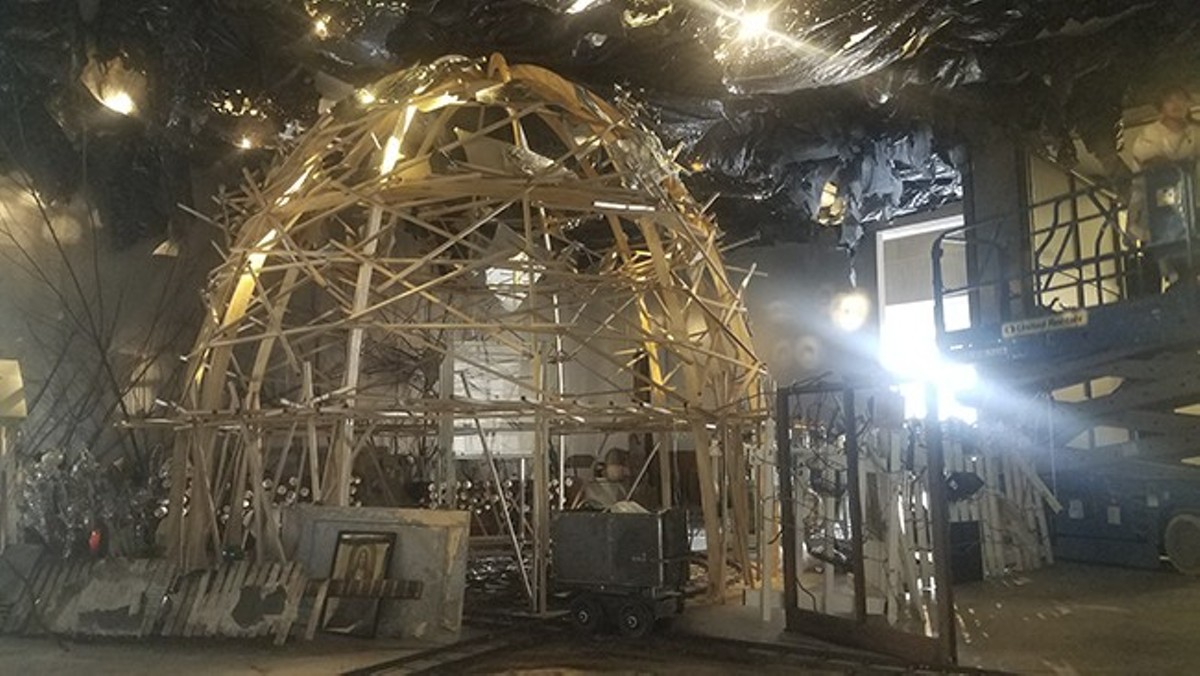Everyone has a relationship with trash," says 35-year-old New York artist Abigail DeVille, whose site-specific installation St. Louis Blues currently occupies an entire room of its own at CAM as part of its Urban Planning group exhibition.
"This is how I look at it: objects are passive witnesses of history, or records of the present historical moment — I mean, the things that they have in the Natural History Museum are people's trash from a couple thousand years ago!" she continues, explaining her fixation with finding and incorporating discarded objects and other urban detritus into her works. Or, as Kelly Shindler, a former associate curator at CAM who returned to guest-curate the exhibition, puts it, "Turning trash into treasure."
Among the objects found in St. Louis Blues are a half-blackened charred door scavenged from an abandoned lot, which sits between two fences: one a white picket fence wrapped with Christmas ball ornaments and barbed wire, the other covered with pots and pans and other reflective utensils. It all surrounds a towering wooden frame in the shape of the dome of St. Louis' Old Courthouse. A large-scale model train, carrying a boxcar of bones, travels in and out of the structure in a figure-eight loop.

It's all highly symbolic, touching on the issues of marginalized people and places that form a thread through all of her work.
"I was consciously thinking about two kinds of spaces that I wanted to create: one more in line loosely with African-American domestic spaces, and then one of kind of 1950s suburbia, with the white picket fence," she explains. "There are different objects on one fence that you won't find on the other, like the rusty tools, [invoking] lost kinds of labor in terms of industrial jobs, but also people that have been waiting on promises that have never been made good."
Taking part in the exhibition led to DeVille's first visit to St. Louis. Part of her artistic process — which has taken her through explorations of Baltimore, Washington, D.C., Savannah, and her home stomping grounds of New York — is to "go to a place and explore the lay of the land, and try to figure out what aspect of the history I'm interested in, and then kind of building from there."
In particular, she looks for alternative histories: "I want to know what's really happening here from the people who experienced it, rather than whatever makes it into the dominant narrative of the location." St. Louis was mostly a mystery, she says: "The only thing I knew about St. Louis was what happened with Mike Brown and Ferguson. It's interesting to experience a city that you've never been to, you don't know what's really going on, but your idea of it is shaped through the media."
In her research and exploration of St. Louis, DeVille was drawn to the Old Courthouse — in particular, its history as a site of slave auctions and the location of the Dred Scott trials.
"Immediately, I felt impacted by the history there," she says. "Spaces are charged; I feel that buildings retain memory. I don't know what it is, but spaces contain memories of the trauma that happened here. I responded to [the Old Courthouse] immediately, and I knew that the structure of the conversation should be around this building and the structure of the dome, and to continue thinking about what lives outside of justice, or what is justice? So that's why the rest of the materials that are in around the sculpture have to do with things that sprawl from there. The root of the conversation is the history and laws, who they're enacted for and what grows out from that."
"I also saw a report about redlining in St. Louis before I got here, so I knew I wanted to talk about that as well," she continues. In particular, the inclusion of the model train constantly looping around the sculpture — which DeVille had made specifically to scale for the gallery space, a rare object specifically commissioned for her art, rather than found — doesn't just reference St. Louis' location as a transportation hub. The endlessly circulating train, she says, is "a casual reference to infinity, like we could keep going around the same problems, the same conversations, over and over again.
"People keep living and dying, and it's the same nonsense. Are we actually going to move out of this trap, this little quagmire that we're in, being unable to deal with history?"






